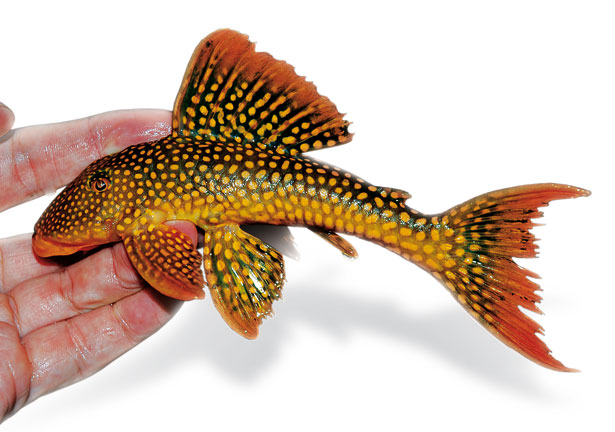
Freshly caught, half-grown specimens of Scobinancistrus aureatus do justice to their popular name, Sunshine Pleco.
by Rajanta Sinardja Rahardja
Excerpt from AMAZONAS, Sept/October 2012
In recent years numerous loricariid catfish species have been bred in the aquarium. One species whose breeding has only been rumored up until now is the Sunshine Pleco, Scobinancistrus aureatus. This article describes my attempts to breed the species professionally in our hatchery.
Peace and quiet
The beautiful Sunshine Pleco is native to the middle and lower Río Xingu. Juveniles and half-grown specimens live in water depths of 3.28–9.8 feet (1–3 m), while adults inhabit the very dark environment of deeper water. To replicate their natural environment, we keep our loricariid catfishes in a darkened room; the only light comes from one open door. Only during daily maintenance and feeding do we turn on a dim light. We are sure that this is a major element in our success, and not just with this particular catfish species. Obviously, it would be impractical for the average aquarist to keep fishes in pitch-dark rooms, but it is worth trying with species that have so far resisted attempts to get them to breed.
The aquariums we set up for our Sunshine Plecos measure 80 x 32 x 28 inches (200 x 80 x 70 cm) and hold 250 gallons (960 L) of water. The bottom is covered with a layer of gravel about 2 inches (5 cm) deep, with an undergravel filter beneath. We installed powerful current pumps to circulate the water and assure a high oxygen content, without which successful breeding is unlikely.
Rectangular breeding caves
In the middle of each breeding tank there is a large piece of wood, which the females like to sit on and use as cover. At each corner of the tank we placed specially manufactured ceramic pipes for the males, which they readily accepted as hiding places and, subsequently, as breeding caves. The caves measure 15 x 4 x 3.125 inches (38 x 10 x 8 cm). In addition to the rectangular shape, it is important that both male and female can disappear
completely into the cave to spawn. The long pipes are placed on the bottom and have a slightly roughened inner surface. The shape and design of the caves prevent the eggs from being fanned out. We have had that problem with other species using tubular breeding caves with smooth interiors, and since we changed there have been no further problems of that kind.
We set the water temperature to 82.5°F (28°C). We use aged spring water that has an average general hardness of 4°dGH and a pH of 7.5. About 50 percent of the water is changed several times weekly, so there is no measurable nitrite or nitrate. The low nitrogen content and the high oxygen level, combined with a relatively high water temperature, are prerequisites for successful breeding. This applies to all loricariid catfishes from the clearwater rivers of the Brazilian Shield.
We feed the adult fishes once a day, shortly before nightfall. After the food has been given there is complete darkness in the aquarium room and the fishes can feed undisturbed. We use Hikari Algae Wafers, foodfish pellets with a relatively high protein content (trout pellets), sometimes boiled snails, and a strip of squash once a week to ensure adequate roughage. Regular feeding, always at the same time of day, appears to be important. These fishes are greedy feeders, and once they have settled in they will also eat during the day when a small amount of light streams in the open door. Because they consume an enormous amount, the breeder must be careful not to give them too much, or the water quality will suffer.
READ more. Subscribe today to AMAZONAS Magazine and get instant access to the current Digital Edition, followed by a full year of world-class print issues delivered to your home or business. Click to learn more.






Trackbacks/Pingbacks